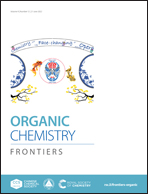Cooperative palladium-catalyzed P(NEt2)3-mediated (4 + 1) annulation of isatins with 2 hydroxymethylallylcarbonates†
Abstract
P(NR2)3-promoted transformations of isatins with electron-withdrawing alkenes have received consistent attention over the last few decades. However, no example involving chemical transformations of nonactivated or weakly activated alkenes has been discovered in the presence of P(NR2)3 organomedia. In the current work, as a complement of this type of reaction, we first developed highly efficient (4 + 1) annulations of isatin derivatives with [2-(hydroxymethyl)allyl] carbonates by deploying a cooperative palladium/P(NEt2)3 system, leading to an extensive library of highly structurally diverse spirooxindole derivatives. Under the assistance of the palladium catalyst, the cooperative strategy effectively reduced the activation barrier of nonactivated or weakly activated alkenes and realized the otherwise kinetically disfavored nucleophilic addition of the Kukhtin–Ramirez adducts with nonactivated or weakly activated alkenes. The novel strategy dramatically expanded the scope of application of phosphine organomedia by opening up new metal/organomedium-catalyzed reaction pathways. Furthermore, this cycloaddition reaction can be efficiently scaled up, and several synthetic transformations were also accomplished. In addition, asymmetric versions using achiral P(NMe2)3 with a chiral palladium complex were investigated, and moderately good results were obtained.



 Please wait while we load your content...
Please wait while we load your content...